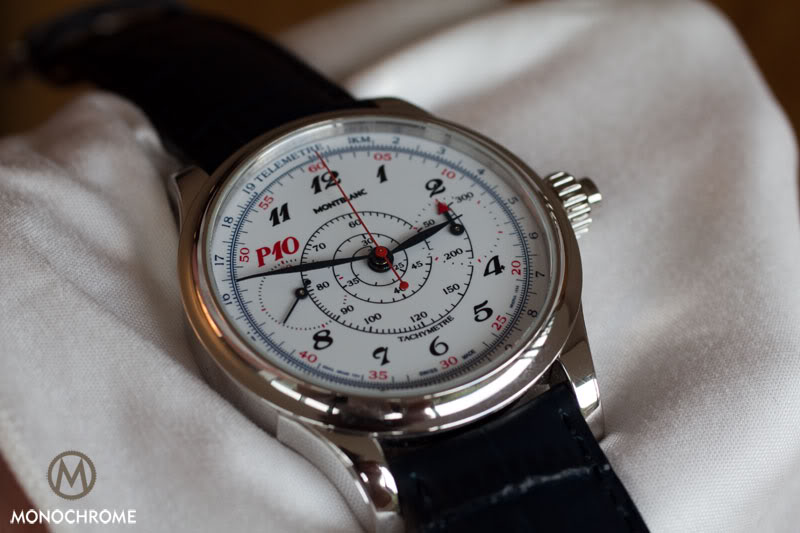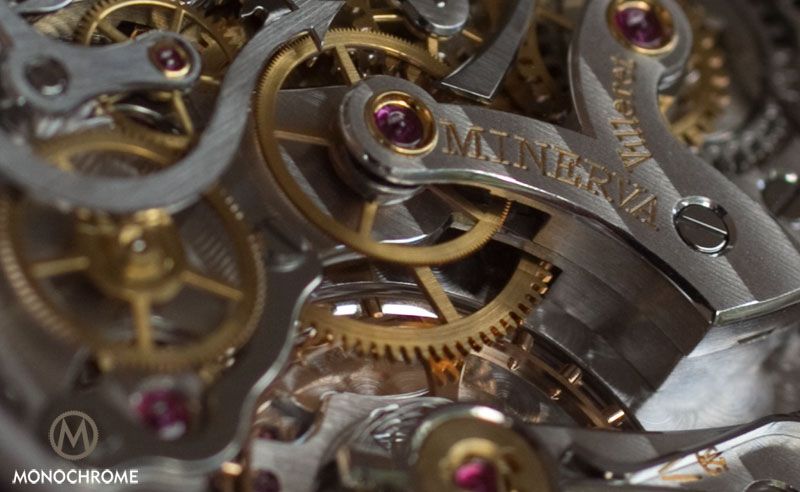Montblanc Collection Villeret 1858 Vintage Chronographe PuristS 10th Edition

Earlier this year many watch brands and independent watchmakers celebrated the 10th anniversary of watch forum The PuristS Pro by creating special editions. Montblanc created something special in their Manufacture in Villeret.
When I visited the Montblanc manufacture in Villeret last year I got to see this special edition, the Montblanc Vintage Chronographe PuristS 10th Edition, or short the Montblanc P10. A manual wind mono-pusher chronograph with an absolutely gorgeous movement. Now the question arises if the movement is so beautiful that it is serious competition for the Lange und Söhne Double Split?

Most watch aficionados will agree that Lange und Söhne’s Double Split (and also the Datograph) are probably the most beautiful mechanical chronograph movements on the planet. And we agree, however we also have very strong feelings about Minerva chronograph calibers which can be found in the Collection Villeret 1858 from Montblanc now-a-days.
We could do a comparrison on all kinds of aspects, however we think that what it all boils down to is personal taste. Why you might ask? The answer is that both watches are of outstanding quality and the finishing of the movements is of the very highest quality one can find in the watch industry – brushing, Côte de Genève, perlage, chamfering and polishing, all done by hand of course.
Technically there are a few differences, but we don’t expect this ‘battle’ to be decided on the mere fact that the Datograph has a date and fly-back function and the Montblanc doesn’t. We think when it comes to this highest league of horology, personal taste and preference is the only reason to choose for either of these. And like the Lange und Söhne, this Montblanc has a drop-dead gorgeous movement!
Let’s look at some quick & dirty close-up photos we made during our visit of the Manufacture in Villeret.

As you can see the design of the movement is completely different from those made by Lange und Söhne. While Montblanc’s balance is larger, both manufactures make their own balance spring (!!), use a swan neck fine adjustment and choose for the same classical frequency of 18,000 semi-oscillations per hour (2.5 hertz). Montblanc choose for a so-called screw balance (screws in side of the balance), while Lange und Söhne choose for a balance with eccentric poising weights.
Caliber 16.29 has one main spring barrel, with an in-house produced main spring, that delivers 55 hours of power reserve when fully wound.
A very typical thing for vintage Minerva chronographs, are the shapes of the levers and especially the one ending in an arrowed piont. We just love those details!

The V-shaped chronograph-bridge is engraved with “Minerva – Villeret” and features Côte de Genève finish and bevelled edges, all done by hand. The chronograph function of Caliber 16.29 is engaged through a mono-pusher in the crown and uses a column-wheel with classical horizontal coupling to control the chronograph function. The ‘mise en function’, i.e. the exact fitting of the the chronograph-lever, takes many hours of manual craftsmanship to a precision of several 1,000ths of a millimeter.

Telemetre and Tachymeter Scales
The dial shows a coiled or snail scale that was a typical feature on the legendary Minerva chronographs from the 1920s and 1930s. The periphery of the Montblanc P10 dial features a telemeter scale, so the tachymeter scale is placed in the centre, where it is coiled like a snail’s shell.
A telemetre scale makes it possible to measure the distance of a phenomenon which is both visible and audible. The chronograph hand is released at the instant the phenomenon is seen; it is stopped when the sound is heard, and its position on the scale shows at a glance the distance in kilometers (or miles) separating the phenomenon from the observer. Calibration is based on the speed of which sound travels through the air, approximately 340 meters or 1,115 feet per second.
For instance: During a thunderstorm the time that has elapsed between the flash of lightning and the sound of the thunder is registered on the chronograph scale.
The tachymetre scale (the snail shell scale in the center of the dial) is to show the speed of a moving object, such as a vehicle, over a known distance. As the moving vehicle, for instance, passes the starting-point of the measured course whose length corresponds with that used as the basis of calibration, the observer releases the chronograph hand and stops it as the vehicle passes the finishing-point. The figure indicated by the hand on the tachometer scale represents the speed in kilometers or miles per hour.

The diameter is 43.5 mm, height is 12.48 mm, and it has a domed sapphire crystal in the front and a flat sapphire crystal in the case back. The hands are made of blued stainless steel.
The regular Vintage Chronographe was introduced in 2010 as limited editions of 58 pieces in 18K red gold cases with white enamel dials and 58 pieces in 18K white gold cases with black enamel dials. This Vintage Chronograph PuristS 10th Edition comes in white gold, with a white enamel dial and is is limited to 10 pieces.
The Montblanc Collection Villeret 1858 Vintage Chronographe PuristS 10th Edition is for sale for € 41,000 Euro (excluding local taxes). Availability through The PuristS Pro website.




2 responses
Beautiful, they really did a great job with the Minerva brand.